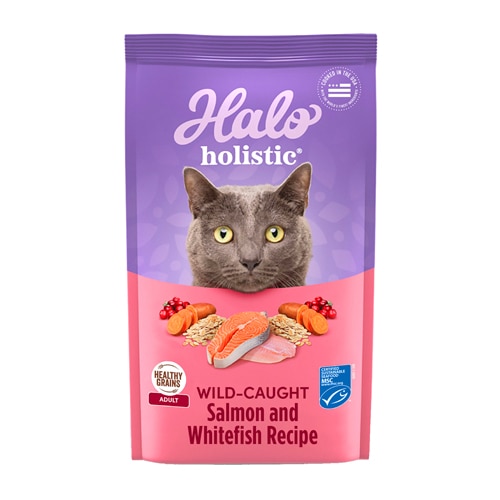As pets are increasingly considered members of the family, their nutritional needs are getting as much attention as the non-furry members of the household. A growing amount of research shows that a poor diet can be as detrimental to a dog or cat as it can be to a child.
Just as with people, studies show that pets that eat more nutritious foods are more likely to be at a good weight and have higher antioxidant intake, which makes them less prone to cancer and other long-term diseases,” says Ken Pawlowski, DVM, of Banfield Pet Hospital in Folsom, Calif. “I’ve seen dogs that eat a good diet and still look healthy at age 14, and dogs that eat poor-quality food that look ancient at 8 or 9 years old.”
Pet food manufacturers are recognizing this and consequently, more high-quality dog and cat foods are on pet store shelves. But ingredient decks that tout everything from bison to blueberries can confuse even the most conscientious pet parent. Here’s what you need to know to choose the best food for your dog or cat.
Play the percentages
Just like humans, dogs and cats need adequate amounts of protein, fat, carbohydrates, vitamins and minerals. According to the Association of American Feed Control Officials (AAFCO), a non-profit that sets standards for the safety of animal food, adult cats need a diet that is at least 26 percent protein and 9 percent fat, and adult dogs should consume a minimum of 18 percent protein and 5 percent fat. Those numbers jump to 30 percent protein and 9 percent fat for kittens and pregnant cats, and 22 percent protein and 8 percent fat for puppies and pregnant dogs.
Studies show a young-to-middle-aged, healthy dog or cat will likely not be affected by eating too much protein, Pawlowski says, “but be wary in older or sick pets.” In general, he says, the more active dogs or cats are, the more protein they should eat.
Most commercial dry pet foods contain between 30 and 70 percent carbohydrates, says Mindy Bough, vice president of the American Society for the Prevention of Cruelty to Animals’ Poison Control Center. “As is evidenced by this wide range, there is some debate over how much is ideal,” she says.
AAFCO also determines the amount of vitamins, minerals and other nutrients dogs and cats need. If you have a cat, make sure to check the requirements for taurine, which is an essential amino acid that felines must get from their diets.
Watch for allergies
Beef, dairy products and wheat are the most common allergens in dogs, and beef, dairy products and fish are the most common allergens in cats, Bough says. If your pet has allergy symptoms such as itching, vomiting, diarrhea, weight loss, chronic ear infections or frequent chewing of the feet, your vet may put it on an elimination diet to determine whether a specific food ingredient is the culprit.
That’s why Pawlowski believes it’s a bad idea to frequently change your pets’ protein sources—for instance, rotating beef- and fish-based cat foods. “You’re just exposing your pet to more potential allergens, which makes it harder to determine the source,” he says.
Grains such as wheat and corn can also be allergenic, but only in a minority of pets, Pawlowski says. Although it’s trendy to feed pets a grain-free diet, “there’s nothing inherently bad about grains,” he says. “They can be an excellent source of energy, fiber and micronutrients.” Less-allergenic grains include barley, oats and brown rice.
If you do decide to go grain free, Bough recommends you make sure your pet food contains another good carbohydrate source, such as peas, potatoes or pumpkin.
Rethink raw food
Another trend is to feed dogs and cats raw food, including frozen, dehydrated and freeze-dried varieties. The rationale is the same as for humans—cooking destroys nutrients, so raw food is therefore more nutritionally complete and closer to the diet a dog or cat would eat in the wild.
However, research shows that may not be the case. In March 2001, the Journal of the American Veterinary Medical Association (JAVMA) published a study in which homemade and commercial raw dog foods were analyzed for nutritional content. “All the diets tested had nutrient deficiencies or excesses that could cause serious health problems when used in a long-term feeding program,” the researchers concluded.
What’s more, six studies show that raw pet foods can be contaminated with dangerous bacteria such as E. coli, salmonella and listeria. A study published in JAVMA in February 2006 evaluated 240 samples of raw dog foods and found that “bacterial contamination is common in commercially available raw meat diets, suggesting that there is a risk of foodborne illness in dogs fed these diets, as well as possible risk for humans” who handle these foods.
Because of this disease potential, the American Veterinary Medical Association discourages raw food diets. Dry or canned foods are better options, Pawlowski and Bough say. They don’t recommend one over the other, but do point out that canned food has more moisture, which is good for cats, and chomping on dry food can help clean tartar off pets’ teeth.
Decode the ingredient deck
Most pet experts recommend avoiding foods that contain animal byproducts, which can include feathers, beaks or any other part of an animal, and animal digest, which is a broth that can contain animal byproducts. Pawlowski says raisins or grapes can cause kidney failure in dogs and potentially cats, and large quantities of onion or garlic are toxic for both dogs and cats.
Ingredients to look for include omega-3s, probiotics and antioxidant-rich fruits and vegetables like berries or carrots. “These can all be beneficial but aren’t necessarily a requirement,” Pawlowski says. “Make sure they’re not in the top five ingredients on the label or they could screw up the recommended nutrient profile.”




